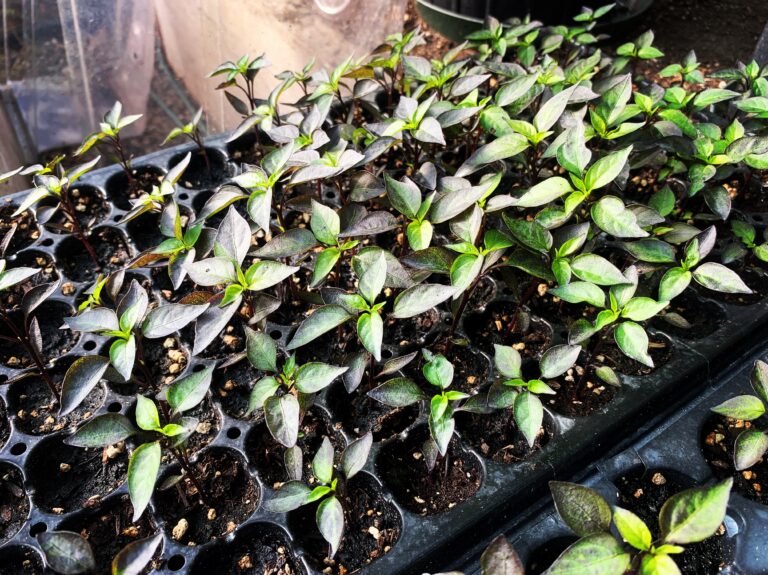By: Luke A. Besmer
I am sure you’ve heard the old saying about how one bad apple spoils the bunch? Well it’s true, and of all things it’s due to a hormonal imbalance. Who’da thunk? So it turns out that in nature, the first ripe apple of the season drops to the ground and begins to decompose. During the decomposition process, the apple releases a gas called Ethylene. Ethylene is a Plant Growth Hormone (PGH) that triggers the nearby apples to fall to the ground and start the decomposition process. The sweet smell of all those decomposing apples attracts foraging animals who eat the apples and spread the seeds far and wide, often with a little fertilizer to boot (or conversely, to overwhelm scavengers so that some seeds are left undisturbed and able to safely germinate). Ethylene and other Plant Growth Hormones are vitally important to all aspects of plant growth and development, understanding them and their uses can improve any gardener’s yield.
Whether a flower sets in the spring or fall, the direction to which it stretches, the size of its fruits, when it drops them to the ground, and virtually every other aspect of plant development is controlled by growth hormones. Signals from the environment trigger production of these powerful compounds. The actual hormones are produced either in the leaves, flowers, shoots, roots or fruits depending on which hormone is in production. They are made on the smooth endoplasmic reticulum within a plant cell, then transported through the cell walls and circulated through the plant’s venous vascular system. Whether part of the normal life cycle or in response to stress, the interacting plant hormones are responsible for all changes in growth.
Plant hormones are grouped into 5 classes depending on their chemical make-up and what they cause to occur, or prevent from occurring in many cases. The five classes are Abscisic Acid, the Auxins, the Cytokinins, the Gibberellins, and Ethylene. The plural is used in listing three of these agents of change due to the fact that there is not one single molecule, but a group of them that have similar function and molecular composition. Let’s look closer at each class of hormone.
The growth regulating Abscisic Acid (ABA) is crucially important for plants trying to make their way out in the harsh realities of nature. Abscisic Acid is built up in developing seed-coats, when a seed falls to earth the slow dissipation of abscisic acid levels causes the seeds to break dormancy. This is a very important trait in frozen climates because if a seed were to germinate too early, say in a late Indian Summer, set roots and begin to grow, it would only perish after the first frost, wasting a chance at regeneration. Mother Nature set up a natural timer with ABA. Certain plants have high amounts of ABA stored in their seed coats. Perennial pine seeds for instance, need to be stratified (forced germination through mimicking of winter conditions) for several months prior to germination. The stratification process is necessary to dissipate the ABA levels in the seed, allowing it to slowly slip out of dormancy. Some short lived annuals, on the other hand, have low levels of ABA and can pop overnight. ABA also helps in stomata regulation during times of water stress. In a back and forth communication between roots and leaves, ABA is produced and used to modify potassium and sodium levels in the guard cells, causing the stomata to close and the plant to save water. Each hormone has major and minor roles to play out in the plant’s system. All are equally important.
Next on the roster are the powerful root, shoot, & fruit regulators known as Auxins. High Auxin levels lead to cell wall plasticity, allowing growing cells to stretch out. Bigger cells mean bigger tissues, which mean bigger organs, and bigger organs mean huge fruits and fantastic flowers. The movement of leaves following the path of the sun throughout the day is also due to the magic of Auxin. Auxin is also responsible for phototropism, or the way a plant grows towards the light. By regulating which cells elongate and which don’t, the plant is able to grow directionally.
Cytokinins are easily as important as Auxins, especially considering a plant’s level of one as compared to the other, is kept relationally even. A very simplified explanation: if one level is 50%, the other level is 50%. If one level rises to 60%, the other drops to 40%. If Cytokinin levels are low, the plant produces vegetative growth. As Cytokinin levels increase (and Auxin levels decrease), a plant transitions into flower and fruiting stages. Higher Cytokinin levels cause plants to be bushier, with shorter internodal spacing. There is a really good chance that the secret ingredient in your favorite fertilizer is some mix of Auxins and Cytokinins, balanced precisely to induce your garden to grow one way or another.
Our next plant hormone is Ethylene, and is the reason why one bad apple spoils the bunch. Ethylene is a gas produced as pectin breaks down in the cell walls of a ripening or rotting fruit. The release of ethylene gas by one rotten apple triggers nearby apples to also ripen prematurely, spoiling the entire bunch. A crate of apples goes bad quick once the Eythlene snowball effect starts. Ethylene also plays a role in stem growth, where lower levels correspond to thicker stem growth, it plays a role in phototropism, and the also takes part in the initiation of leaf development.
Last but not least are the Gibberellins, or Gibberellic Acid (GA), depending on who you are talking too. This class of hormones has a lot of responsibility. GAs cause a seeds to start to grow after it has germinated, helping to make sure that the seedling manages food storage while still developing photosynthetic leaves. During vegetative growth, GA also causes stretching, or large internodal spacing. Conversely, flowering plants that are affected by the daylight period length (ie. 12/12 plants) are induced to flower under adjustment of GA levels. GA is used in several growth promoting products that you certainly have heard of.
These five classes of hormones work synergistically to trigger all of the necessary physiological pathways that a plant must undertake in order to complete its life cycle and ensure a next generation. Cytokinins and Auxins balance out to switch from vegetative to flowering growth, Gibberelic Acid and Abciscis acid work together to promote heavier fruiting, Ethylene and Auxin coordinate to cause the dropping of leaves. Low doses of Gibberelic Acid promote growth, while high levels inhibit it. A cocktail of chemicals is constantly flowing through a growing plant, the recipe to which is ever fluctuating.
Speaking of recipes, how about the secret ones that are in some of your favorite grow products? Often the true active ingredient is not listed on the label, that’s why that bottle of Potassium Sulfate seems to make the magic happen. Plant Hormones are definitely on this list of unlisted secret ingredients. Some of the PGHs are common, listed on the label, and entirely safe to use.
If a hormone is made synthetically it is known as a Plant Growth Regulator, or PGR. Two common PGRs are the Auxins: Indole-3-butyric acid (IBA) and napthaleneacetic acid (NAA), which you have likely used in a rooting hormone product. These two mimic the natural hormone IAA (Indoe-3-Acetic Acid), and initiate the formation of a callus and then root development. Using a product with IBA or NAA will help to ensure that time and materials spent taking and sticking cuttings is not wasted.
PGRs can be used like a tools in a tool box, adjusting a garden’s growth to how a grower sees fit. A common problem indoor and green house growers face is running out of room, this can be dealt with by using PGRs that inhibit stem elongation. You may have heard of products that use placobutrazol, flurprimidol, or Trinexapac-ethyl, these stop stems from stretching by inhibiting Gibberellin biosynthesis. Depending on the timing of their use, you can keep vegetative plants shorter for longer, or make a flowering plant produce short, tight internodes with increased lateral branching. Sumagic is a professional grade growth product for ornamental crops that when applied, allows a grower to virtually stop a plant’s growth, “keeping plants from outgrowing their marketability” as their website states. PGRs can be a very useful tool if used properly.
PGRs have a time and place to be used, and due to health and safety reasons some of are meant to be used on ornamental crops only. If you decide to use PGRs, make sure that your crop is listed on the product label as safe for use, use the recommended safety equipment, pay attention to re-entry periods, do a post-harvest rinse of all produce. Personally, I want the benefits of a PGR, but don’t want to mess with the potential side effects of synthetic chemicals. Luckily, Mother Nature has it all figured out. The potent phytohormones (another name for PGHs) are produced in plants, fungi, and algae. They can be directly applied to the garden, or extracted and concentrated into easy to use liquids and powders. Several are in products you may already be using.
Everyone knows about willow bark powder being a great natural rooting hormone. This is due to high amounts of Salicylic Acid present in the bark, especially in white willow (Salix alba). The Salicylic Acid promotes root initiation, causing your cuttings to callous and form roots. Did you know this natural miracle worker also plays a part in inducing Systematic Acquired Resistance (aka SAR), causing a plant to bulk up its entire defense system, thereby reducing chances of future disease or infestation. A foliar spray of willow bark water will toughen up your garden and keep it stronger for longer.
Bet you didn’t know that yeasts produce the auxin, Indole-3-acetic acid, and they excrete it into the nearby environment. Scientists postulate that it may be used as a sensing mechanism, where the concentration in the environment allows the individual yeast cell to approximate how many other yeasts are nearby. Growers can use this mechanism for their own good by promoting root and shoot development. Yeast extracts are likely also on the list of unlisted ingredients that make your garden blast off.
Sprouted Seed Teas (SST) are starting to gain popularity among many probiotic farmers. A sprouting seed is chock-full of the hormones Abscisic and Gibberellic Acid, as well as a bunch of other bioactive enzymes and beneficial proteins. SST’s are made by soaking seeds, often barley or rye, in water until they sprout their radicle (pronounced radical, this is the first bit of root that emerges from a germinating seed, cool huh?), blending the sprouting seeds into a slurry, or just collecting the water they are soaked in. This biologically active liquid can be used in a root drench or foliar spray. Plants will respond to the hormones with root and shoot development, cell elongation, and the promotion of heavy flowering. Hemp SST anyone?
Another common and important source of natural plant hormones is algae, aka kelp. Kelp products contain Auxins, Gibberellins, and Cytokinins, causing your garden to grow more leaves, stimulate flowering, increase lateral branching, develop more roots, divide more cells, etc., etc., etc… Different products will have different concentrations and ratios depending on the extraction and concentration process and the type of kelp used. It is the high Cytokinin levels that cause Giant Kelp (Macrocystis pyrifera) to grow up to 2 feet per day. Though that kind of growth might get out of hand even in the largest of warehouse gardens.
Plant Growth Hormones are like tools in a tool chest. Using the right product at the right time allows a grower to tailor a garden how they see fit. One can induce vertical growth and leaf development to meet vegetative growth goals, and then stop vertical growth and promote lateral branching and flower initiation to finish big. Or, hold those unsold clones a couple weeks longer by halting growth altogether. Wise use of phytohormones can bring your gardening to the next level, just remember to watch out for the bad apples.



